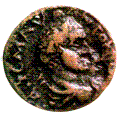A draft of the early proto-Luke reached the hands of a bishop – himself the son of a bishop who claimed to have known Paul – and in consequence enjoyed immense prestige. This was Marcion, one of the earliest ‘Catholics’ to address the issue of a ‘defined gospel’.
A wealthy ship owner from Sinope (modern Sinop, on the Turkish Black Sea coast), Marcion had helped fund the bishopric of Rome. While residing in the imperial capital Marcion revised ‘proto-Luke’ and published (about 140) the first ‘new testament’ (the term itself was not used until the early third century), calling it simply ‘Evangelicon’ (or ‘Gospel of the Lord’ ), a slim, single volume, to which he appended ten of Paul’s epistles (the ‘Apostolicon’’).
Marcion rejected all other scripture, including Jewish scripture in its entirety, arguing that Yahweh was a cruel god, completely separate from the loving god spoken of by Paul. Thus for Marcion there were two gods, the lesser of which was Yahweh, the creator god. The loving god’s “Grace” would replace “The Law ” of the harsh god. The body must die, said Marcion. Only the soul would be resurrected. The flesh had to be overcome by the spirit, or loving god, revealed in Christ.
In this gospel (which Marcion attributed to Paul himself), there is no nativity, no baptism.
Marcion’s Christ descends fully grown from heaven (as had a number of Greek gods), and appears suddenly in a synagogue in Capernaum. In other respects his text follows closely the wording which would eventually be found in Luke.
Marcion preached and evangelised for more than twenty years. But he fell out with his acolytes in Rome and returned to Asia Minor to establish his own church hierarchy. Marcionites were soon to be found throughout the Roman Empire. In the east, this particular Christianity thrived for centuries and survived into the early Middle Ages.
In practical terms, the diverse Christians retrenched, a minority still filled with hope for an imminent ‘Day of the Lord’, but others feeling their way towards an established Church.
What the Christians lacked in original doctrine they made up for in astute organisation. Borrowing freely from Jewish precedents, the Christians set up ‘prayer houses’ to rival synagogues, appointed priests to read approved texts, and collected money and property to serve the faith. Their cult had survived the wars by embracing, not opposing, authority and now it demanded of its converts discipline and compliance. Judaism had been rent and fatally weakened by its divisions; in their plans for a ‘Universal Church’ the Christians would have no place for dissent. Ironically, this striving for monolithic organisation would ensure factionalism and ‘heresy’ for centuries.
As the largest city in the region, and the home of the largest community of displaced Jews, Alexandria, became the leading centre for an organised Christian church. The city that, in the work of Philo, had already contributed the notion of ‘Logos’, now gave the world the first recognisable ‘Christianity.’ It was in Alexandria that some of the most notable church ‘fathers’ would pontificate. It was from Alexandria that some of the most important Christian heresies would originate. And it was in Alexandria that some of the worse excesses of Christian terrorism were perpetrated.
Correspondence of Emperor Hadrian refers to Alexandrian worshippers of the sun-god Serapis calling themselves ‘Bishops of Christ’:
“Egypt, which you commended to me, my dearest Servianus, I have found to be wholly fickle and inconsistent, and continually wafted about by every breath of fame. The worshippers of Serapis are called Christians, and those who are devoted to the god Serapis, call themselves Bishops of Christ.”
.
– Hadrian to Servianus, 134 AD (Quoted by Giles, Hebrew and Christian Records, vol. ii, p86, 1877)
.
The reference is intriguing. In the cult of Serapis, Graeco-Roman and Pharaonic religion had already mingled. The cult of Lord Serapis was of comparatively recent origin, having been established by the former general of Alexander, Ptolemy I Soter (304 – 284 BC). His new god (a transliteration, via Zaparrus, of Asar-Hapi) had replaced the more ancient linked Egyptian gods Osirus and Apis and formed part of an Egyptian trinity shared with Isis (the Mother!) and Horus (the Divine Child!).
Ptolemy’s idea was to have a unifying, national god, worshipped by all his subjects. Accordingly, Serapis had been given characteristics drawn from both Egyptian and Greek deities. The child Horus, it should be noted, was held to have been born in a stable on December 25th and the mother, Isis, to have been a virgin! For the Egyptians, Horus had been a god of the underworld and judge of the dead. One of the many titles that would be given to Christ was Judge … that celestial arbiter on the day of judgement!
That the syncretic process should have continued with the additional fusion of the Jewish godman legend is no more than we would expect – and the result was Christian scripture!








